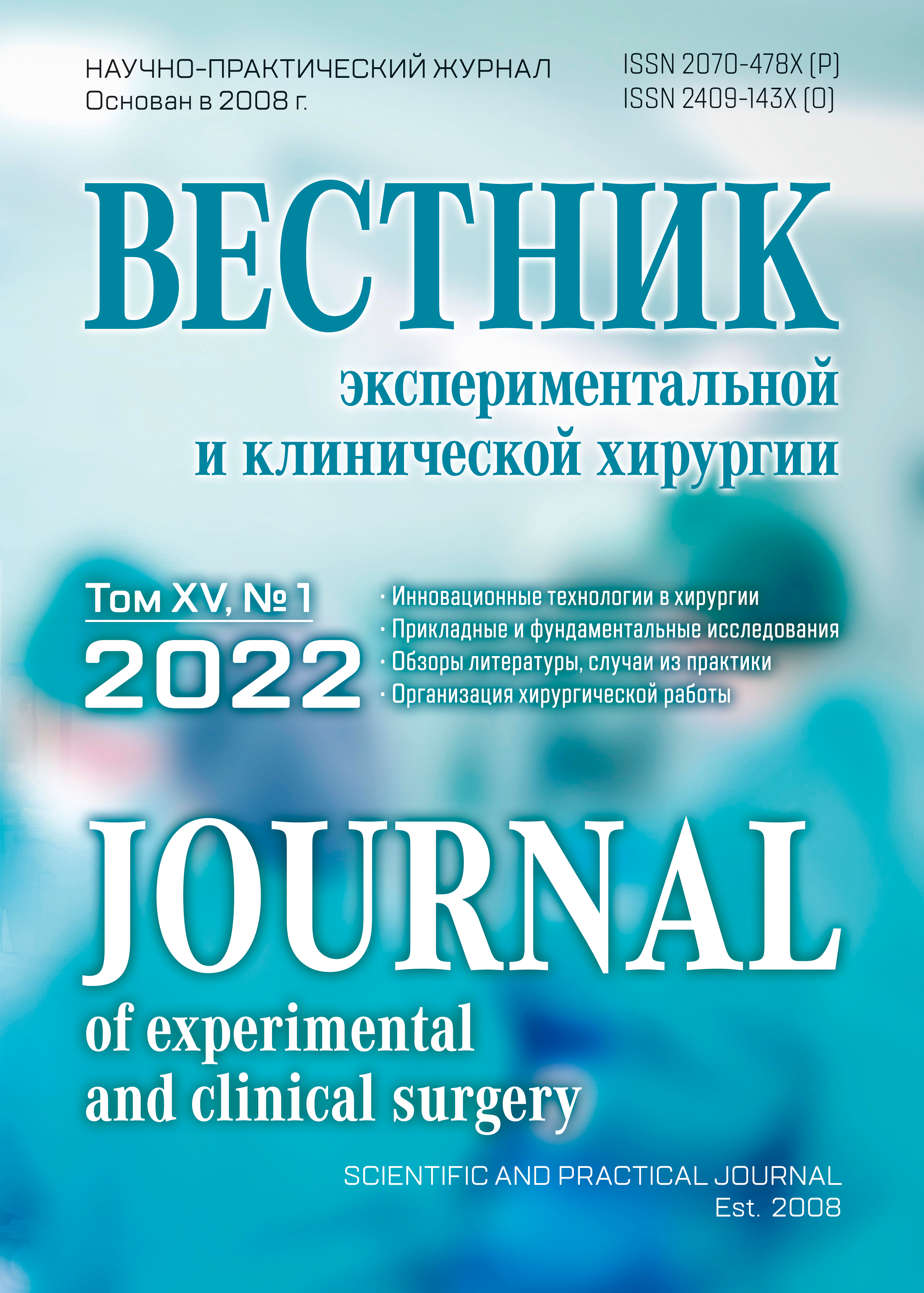Features to Prevent Failed Hardware Colorectal Anastomoses in Laparoscopic Rectal Resections
- Authors: Ivanov Y.V.1,2,3, Panchenkov D.N.1,2, Lomakin I.A.4, Istomin N.P.5, Velichko E.A.6, Danilina E.S.1,5
-
Affiliations:
- Federal Research and Clinical Center for Specialized Types of Medical Care and Medical Technologies of the Federal Medical and Biological Agency of the Russian Federation
- Moscow State Medical and Dental University named after A. I. Evdokimov, Ministry of Health of the Russian Federation
- 72 nd Central Polyclinic of the Ministry of Emergency Situations of the Russian Federation
- Academy for postgraduate education Federal Research and Clinical Center for Specialized Types of Medical Care and Medical Technologies of the Federal Medical and Biological Agency of the Russian Federation
- Academy of Postgraduate Education of the Federal scientific clinical center of FMBA Russia
- Issue: Vol 15, No 1 (2022)
- Pages: 10-17
- Section: Original articles
- URL: https://vestnik-surgery.com/journal/article/view/1525
- DOI: https://doi.org/10.18499/2070-478X-2022-15-1-10-17
- ID: 1525
Cite item
Full Text
Abstract
The aim of research was to study proper results of laparoscopic anterior rectal resection using intraoperative measures to prevent failure of hardware colorectal anastomoses in patients with rectal tumor.
Material and methods. Out of 68 patients included in the study, colorectal anastomotic leakage occurred clinically only in 2 cases (2.9%, class A and B) and required no further surgical interventions. When evaluating the risk of colorectal anastomosis failure in each specific case, it is necessary to consider pre- and intraoperative risk factors. Formation of colorectal anastomosis with one angular end of the rectal stump followed by immersion; additional strengthening of the anastomosis zone with interrupted serous-muscular sutures; adequate drainage of the pelvic cavity (the most effective - transperineal presacral) are intraoperative methods that reduce the risk of failed hardware colorectal anastomoses.
Results. Out of 68 operated patients, colorectal anastomosis failure occurred clinically only in 2 cases (2.9%, class A and B) and did not require repeated surgical intervention. When assessing the risk of colorectal anastomosis failure in each specific case, it is necessary to take into account pre-and intraoperative risk factors. Formation of a colorectal anastomosis with one angular end of the rectal stump, followed by its immersion; additional strengthening of the anastomosis zone with nodular serous-muscular sutures; adequate drainage of the pelvic cavity (most effectively - trans-interventional presacral) - intraoperative methods that reduce the risk of failure of hardware colorectal anastomoses.
Conclusion. Reasonable doubts in the intraoperative evaluation of the blood supply to the end section of the descending colon, viability of the colorectal anastomosis, presence of 3 or more risk factors, low position of anastomosis (less than 10 cm from the outer end of the anal canal) indicate the necessity to form preventive transversostomy.
Full Text
About the authors
Yuriy Viktorovich Ivanov
Federal Research and Clinical Center for Specialized Types of Medical Care and Medical Technologies of the Federal Medical and Biological Agency of the Russian Federation; Moscow State Medical and Dental University named after A. I. Evdokimov, Ministry of Health of the Russian Federation;
Author for correspondence.
Email: ivanovkb83@yandex.ru
ORCID iD: 0000-0001-6209-4194
SPIN-code: 3240-4335
MD, Professor, head of surgery Department, Federal scientific clinical center of FMBA Russia, chief researcher of the laboratory of minimally invasive surgery doctor of MSMSU them. A.I. Evdokimov Ministry of health of Russia
Russian Federation, 115682, Russian Federation, Moscow, 28 Orekhovy Bulvar str., 28; 127473, Russian Federation; Delegatskaya str., 20/1Dmitry Nikolayevich Panchenkov
Federal Research and Clinical Center for Specialized Types of Medical Care and Medical Technologies of the Federal Medical and Biological Agency of the Russian Federation; Moscow State Medical and Dental University named after A. I. Evdokimov, Ministry of Health of the Russian Federation
Email: dnpanchenkov@mail.ru
ORCID iD: 0000-0001-8539-4392
SPIN-code: 4316-4651
M.D. , Professor, head of the laboratory of minimally invasive surgery of MSMSU them. A. I. Evdokimov Ministry of health of Russia
Russian Federation, 115682, Russian Federation, Moscow, Orekhovy Bulvar str., 28; 127473, Russian Federation, Moscow, Delegatskaya str., 20/1Ivan Alexandrovich Lomakin
72 nd Central Polyclinic of the Ministry of Emergency Situations of the Russian Federation
Email: surgeon2@mail.ru
ORCID iD: 0000-0002-9734-7507
surgeon of the 72 nd Central Polyclinic of the Ministry of Emergency Situations of the Russian Federation
Russian Federation, 121357, Moscow, Vatutina str., 1, Russian FederationNikolay Petrovich Istomin
Academy for postgraduate education Federal Research and Clinical Center for Specialized Types of Medical Care and Medical Technologies of the Federal Medical and Biological Agency of the Russian Federation
Email: nistomin46@mail.ru
ORCID iD: 0000-0002-0615-2588
M.D., professor of the department of surgery
Russian Federation, 125371, Moscow, Volokolamsk highway, d. 91, Russian FederationEvgeny Alexandrovich Velichko
Academy of Postgraduate Education of the Federal scientific clinical center of FMBA Russia
Email: velichko_eugen@mail.ru
ORCID iD: 0000-0002-0297-8155
SPIN-code: 9817-2850
Ph.D., associate professor of the department of surgery of the Academy of Postgraduate Education of the Federal scientific clinical center of FMBA Russia
Russian Federation, 125371, Moscow, Volokolamsk highway, 91, Russian Federation.Ekaterina Stanislavovna Danilina
Federal Research and Clinical Center for Specialized Types of Medical Care and Medical Technologies of the Federal Medical and Biological Agency of the Russian Federation; Academy for postgraduate education Federal Research and Clinical Center for Specialized Types of Medical Care and Medical Technologies of the Federal Medical and Biological Agency of the Russian Federation
Email: danilina.katja@bk.ru
ORCID iD: 0000-0002-2466-3795
surgeon of the department of surgery of the Federal scientific clinical center of FMBA Russia, senior laboratory assistant of the department of surgery of the Academy of Postgraduate Education of the Federal scientific clinical center of FMBA Russia
Russian Federation, 115682, Russian Federation, Moscow, Orekhovy Bulvar str., 28; 125371, Russian Federation, Moscow, Volokolamsk highway, 91References
- Kit OI, Gevorkyan YuA, Soldatkina NV. Ways to improve the results of using hardware anastomosis in rectal cancer surgery. Khirurgiya. 2013;12:37-42. (in Russ.)
- Maeda K, Nagahara H, Shibutani M, Ohtani H, Sakurai K, Toyokawa T, Muguruma K, Tanaka H, Amano R, Kimura K, Sugano K, Ikeya T, Iseki Y, Hirakawa K. Efficacy of intracorporeal reinforcing sutures for amastomotic leakage after laparoscopic surgery for rectal cancer. Surg. Endoscopy Published Online First. 2015. https://doi.org/10.1007/s00464-015-4104-2.
- Alekseev MV, Shelygin YuA, Rybakov EG. Transanal strengthening of low colorectal anastomosis: first experience and prospects. Koloproktologiya. 2016;4(58):15-21. https://doi.org/10.33878/2073-7556-2016-0-4-15-21.
- Popov DE. Risk factors for colorectal anastomosis failure in patients with rectal cancer. Koloproktologiya. 2014;2(48):48-56.(in Russ.)
- Cherdantsev DV., Pozdnyakov A.A., Shpak V.V., Ryabkov Yu.V., Popov A.E. Colorectal anastomosis fail-ure. The current state of the problem (literature review). Koloproktologiya. 2015;4(54):57–63. (in Russ.)
- Akhmetzyanov FSh, Egorov VI. Failure of colorectal anastomosis sutures (literature review). Sibirskii onkologicheskii zhurnal. 2016;2(15):107-112. https://doi.org/10.21294/1814-4861-2016-15-2-107-112. (in Russ.)
- Balkarov AA, Rybakov EG, Ponomarenko AA, Alekseev MV, Kashnikov VN. Strengthening of colorectal anastomosis as a method of preventing its insolvency. Koloproktologiya. 2018;4(66):16-24 (in Russ.)
- Vlasov AA. Method of prevention of insolvency of colonic anastomosis. Journal of Siberian Medical Sciences. 2015;2:21-29 (in Russ.)
- Alekseev MV, Shelygin YuA, Rybakov EG. Methods of prevention of colorectal anastomosis failure (literature review). Koloproktologiya. 2015;4(54):46-56 (in Russ.)
- Kang CY, Halabi WJ, Chaudhry ОО, Nguyen V, Pigazzi А, Carmichael JС, Mills S, Stamos MJ. Risk factors for anastomotic leakage after anterior resection for rectal cancer. JAMA Surg. 2013;148(1):65-71. https://doi.org/10.1001/2013.jamasurg.2.
- Latal S, Pai VD, Demenezez J, Desouza A, Saklani AP. Analysis of risk factors and management of anastomotic leakage after rectal cancer surgery: an Indian Series. Indian J. Surg. Oncol. 2016;7(1):37-43. https://doi.org/10.1007/s13193-015-0457-1.
- Parthasarathy M, Greensmith M, Bowers D, Groot-Wassink T. Risk factors for anastomotic leakage after colorectal resection a retrospective analysis of 17518 patients. Colorectal Dis. 2017;19(3):288-298. https://doi.org/10.1111/codi.13476.
- Anderin K, Gustafsson UO, Thorell A, Nygren J. The effect of diverting stoma on postoperative morbidity after low anterior resection for rectal cancer in patients treated within an ERAS program. EJSO. 2015;41:724-730. https://doi.org/10.1016/j.ejso.2015.03.234.
- Wu SW, Ma CC, Yang CS. Role of protective stoma in low anterior resection for rectal cancer: a meta-analysis. World J. Gastroenterol. 2014;47(20;21):18031-18037. https://doi.org/10.3748/wjg.v20.i47.18031.
- Matthiessen P, Hallbook O, Rutegard J. Simert G, Sjödahl R. Defunctioning stoma reduces symptomatic anastomotic leakage after low anterior resection of the rectum for cancer: a randomized multicenter trial. Ann. Surg. 2007;246:207-214. https://doi.org/10.1097/SLA. 0b013e3180603024.
- Zong Z, Zhou T, Jiang Z, Li Y, Yang B, Hou Z, Han F, Chen S. Temporary tube stoma versus conventional loop stoma for the protection of a low anastomosis in colorectal surgery: A systematic review and meta-analysis. The American surgeon. 2016;82(3):251-258.
Supplementary files














